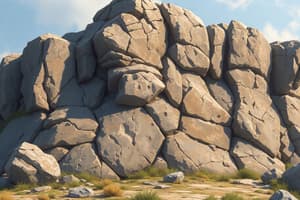Podcast
Questions and Answers
Which type of building material is primarily formed through natural processes?
Which type of building material is primarily formed through natural processes?
- Concrete
- Wood (correct)
- Steel
- Glass
What are composite materials primarily made of?
What are composite materials primarily made of?
- Pure minerals
- A combination of two or more materials (correct)
- Natural occurring substances
- A single element
Which classification of rocks is formed from the cooling of magma?
Which classification of rocks is formed from the cooling of magma?
- Sedimentary rocks
- Fossils
- Metamorphic rocks
- Igneous rocks (correct)
Which type of rock is created from weathering and deposition?
Which type of rock is created from weathering and deposition?
Metamorphic rocks are formed as a result of what process?
Metamorphic rocks are formed as a result of what process?
What characterizes sedimentary rocks in terms of their formation process?
What characterizes sedimentary rocks in terms of their formation process?
Which of the following describes the source of stone materials?
Which of the following describes the source of stone materials?
Which type of rock can be categorized as Plutonic due to its formation process?
Which type of rock can be categorized as Plutonic due to its formation process?
Which classification of rocks has no definite chemical composition?
Which classification of rocks has no definite chemical composition?
Natural stones are critical in construction primarily because they are:
Natural stones are critical in construction primarily because they are:
What is the process called when igneous and sedimentary rocks change under heat and pressure?
What is the process called when igneous and sedimentary rocks change under heat and pressure?
Which of the following is an example of stratified rocks?
Which of the following is an example of stratified rocks?
What distinguishes foliated rocks from other types of rocks?
What distinguishes foliated rocks from other types of rocks?
Which of the following types of rocks mostly contain silica as their main component?
Which of the following types of rocks mostly contain silica as their main component?
What is a key characteristic of argillaceous rocks?
What is a key characteristic of argillaceous rocks?
Which requirement for good building stones relates to their ability to withstand external factors?
Which requirement for good building stones relates to their ability to withstand external factors?
What is the minimum crushing strength requirement for a good building stone?
What is the minimum crushing strength requirement for a good building stone?
Which of the following is an example of a calcareous rock?
Which of the following is an example of a calcareous rock?
Which type of rocks are not stratified and have crystalline grains?
Which type of rocks are not stratified and have crystalline grains?
What is a desired characteristic of building stones regarding their appearance?
What is a desired characteristic of building stones regarding their appearance?
Flashcards
Building Materials
Building Materials
Materials used in building construction, categorized into natural (wood, stone), artificial (bricks, cement), and composite (concrete, plywood).
Stones
Stones
Naturally occurring rocks found in the earth's crust, used in construction and as aggregates in concrete.
Weathering
Weathering
Refers to the process of breaking down rocks into smaller particles due to exposure to weather elements like frost, rain, and wind.
Geological Classification
Geological Classification
Signup and view all the flashcards
Igneous Rocks
Igneous Rocks
Signup and view all the flashcards
Sedimentary Rocks
Sedimentary Rocks
Signup and view all the flashcards
Metamorphic Rocks
Metamorphic Rocks
Signup and view all the flashcards
Magma
Magma
Signup and view all the flashcards
Transportation
Transportation
Signup and view all the flashcards
Metamorphism
Metamorphism
Signup and view all the flashcards
Stratified Rocks
Stratified Rocks
Signup and view all the flashcards
Unstratified Rocks
Unstratified Rocks
Signup and view all the flashcards
Foliated Rocks
Foliated Rocks
Signup and view all the flashcards
Silicious Rocks
Silicious Rocks
Signup and view all the flashcards
Argillaceous Rocks
Argillaceous Rocks
Signup and view all the flashcards
Calcareous Rocks
Calcareous Rocks
Signup and view all the flashcards
Crushing Strength
Crushing Strength
Signup and view all the flashcards
Appearance
Appearance
Signup and view all the flashcards
Durability
Durability
Signup and view all the flashcards
Study Notes
Building Materials: Stones
- Stones are naturally occurring materials commonly used in construction, serving as aggregates for concrete and a key component in historic monuments
- Stone prices increase with more complex shaping and texturing
- Stones originate from rock, with varied chemical compositions and forms
- Stones are categorized based on geological, physical, and chemical properties
Geological Classification of Stones
- Igneous Rocks: Formed from cooled magma (molten rock). Include Plutonic, Hypabyssal, and Volcanic rocks
- Sedimentary Rocks: Formed from deposited weathered material from pre-existing rocks. Agents of transport include frost, rain, wind, and flowing water
- Metamorphic Rocks: Formed by altered igneous or sedimentary rocks under high heat and pressure, a process called metamorphism
Physical Classification of Stones
- Stratified Rocks: Exhibit layered structures (planes of stratification/cleavage), easily splitting along these planes. Examples: sandstone, limestone, slate
- Unstratified Rocks: Lack layering, have compact crystalline grains, and resist splitting. Examples: granite, trap, marble
- Foliated Rocks: Have a tendency to split along a definite direction, though not necessarily parallel like stratified rocks. Common in metamorphic rocks
Chemical Classification of Stones
- Silicious Rocks: Predominantly silica. Hard and durable (e.g., granite, trap, sandstone)
- Argillaceous Rocks: Primarily clay. Hard and durable, but brittle (e.g., slate, laterite)
- Calcareous Rocks: Primarily calcium carbonate. Limestone (sedimentary) and marble (metamorphic)
Requirements for Good Building Stones
- High Crushing Strength: Minimum 100 N/mm² for structural integrity
- Desirable Appearance: Uniform color and aesthetic qualities suitable for facade applications
- Durability: Resistant to chemical weathering, atmospheric influences, and long-term structural integrity, influencing factors include composition, texture, and location within the structure.
Studying That Suits You
Use AI to generate personalized quizzes and flashcards to suit your learning preferences.




